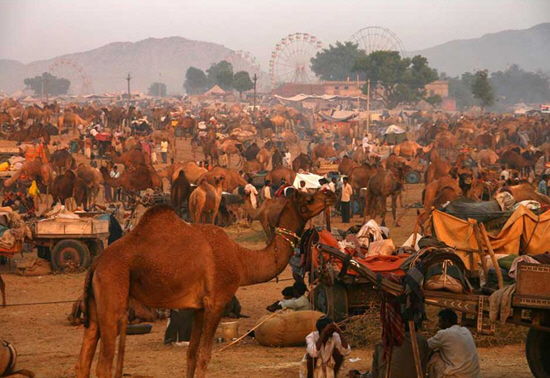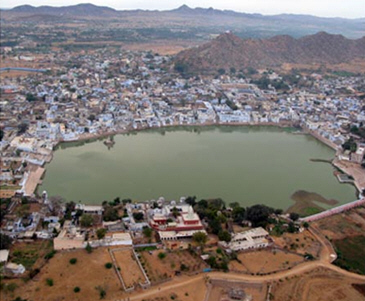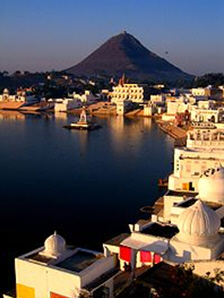Pushkar has 400 temples. Most of the temples are not very old because many temples were destroyed during Muslim conquests in the area. Subsequently, the destroyed temples were rebuilt. The most famous among all is the Brahma Temple built during the 14th century. Very few temples to Lord Brahma exist elsewhere in the world. Other temples of Brahma include Bithoor in UttarPradesh, Khedbrahma in Gujarat, village Asotra of Barmer district in Rajasthan; Uttamar Kovil (one of the DivyaDesams) near Srirangam ; Mother temple of Besakih in Bali, Indonesia; and Prambananin Yogyakarta, Indonesia.
Brahma Temple (Main temple)
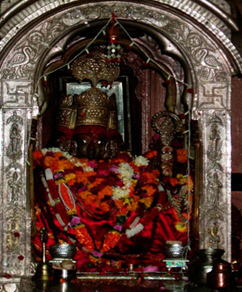
The temple is one of very few existing temples dedicated to creator-god Brahma in India and remains the most prominent among them.
Although the present temple structure dates to the 14th century, the temple is believed to be 2000 years old. There is deity of four headed Brahma with Gayatri on the left and Savitri on the right. Brahma’s central deity is made of marble and was installed in 718 AD by AdiShankara. Brahma is seated in a crossed leg position in the aspect of creation of the universe. It is of life size with four hands, four faces, each oriented in a cardinal direction. The four arms each hold the akshamala (chanting beads), the pustaka (book), the kusha grass and the kamandalu (water pot). These four symbols represent time, knowledge, system of sacrifices to be adopted for sustenance of various life forms in the universe and the causal waters from which the universe emerged. Brahma is riding on his carrier hamsa (swan). There are also deities of Indra and Kubera.
Timings
The temple is open for worship between 6:30 am and 8:30 pm during winter and 6:00 am to 9:00 pm during summer, with an interval in afternoon between 1:30 pm to 3:00 pm when the temple is closed.
The priests at the Brahma temple refer to a strictly followed religious practice. House-holders (married men) are not allowed to enter the sanctum sanctorum to worship the deity. Only sanyasis can perform the puja to the deity.
Temples of Brahma’s Consorts
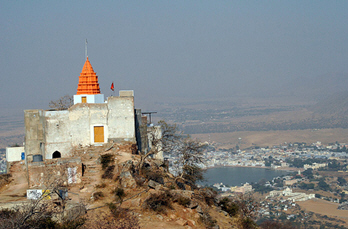
Brahma’s two consorts Savitri and Gayatri mentioned above also have separate temples for them in Pushkar, but on hills at opposite ends of the lake. The first consort Savitri, who cursed Brahma, is described to be still seating annoyed and enraged in her shrine on the highest hill in Pushkar, while Gayatri afraid of Savatri’s wrath sits at a lower hill at the other end, the eastern side of the lake.
Savitri temple located on the top of Ratnagiri hill, behind the Brahma temple, overlooks the Pushkar lake and the sand dunes on its western side. It is reached by one-hour trek over a series of steps on the hill.
Gayatri temple is on other side of town by Marwar bus stand.
Atpateshwar or Apteshwar temple
The Atpateshwar temple, which is situated in a cave next to the Brahma temple, is dedicated to Shiva. This temple was built by Brahma after he found that Shiva attended the Yagna performed by him in the garb of a tantric mendicant holding a skull. When Shiva was approached for this appearance, he was offended and filled the entire area of the yagna site with skulls. The agitated Brahma meditated to know the reason for such a situation, and then he realized that the mendicant was none other than Shiva. Realizing his folly, Brahma requested Shiva to attend the yagna. Shiva then attended the yagna holding the skull and Brahma in appreciation established a temple in honor of Shiva as ‘Atpateshwar’, next to his own temple. The Linga of Shiva is large and is encircled by a snake made of copper.
Varaha Temple

It has beautiful two feet high white deity of Lord Varaha. Lord Varaha is said to have come to Pushkar. The original temple was built in the 12th century.
There are two Raghunath (Lord Ram) temples in Pushkar, the old and new. The deities in the new Raghunath temple are Vaikunthanath and Lakshmi. The deities in old Raghunath temple, built in 1823, are Venugopal, Narasimha and Lakshmi.
